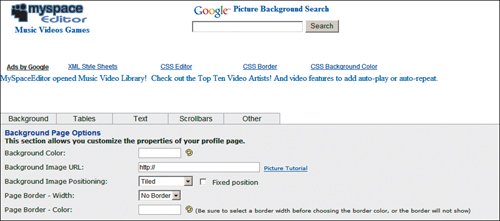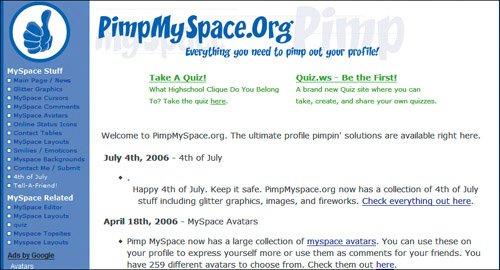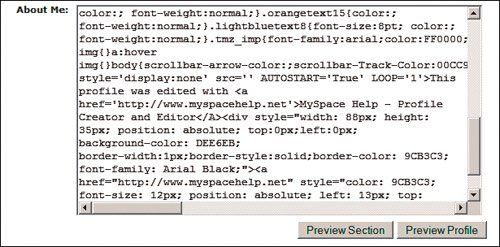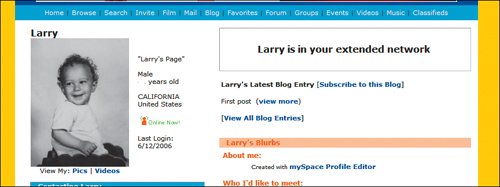Making Profiles Sing and Dance
| It's very easy to add color, graphics, and artistic personality to a MySpace profile by pasting HTML into the appropriate places. We'll explain how to do that in a minute, but first you need to know how to find or generate the code that you want to paste in. That's where MySpace Editors come in handy. Using MySpace EditorsThere are numerous sites on the Web that offer what are called "MySpace editors." They're easy-to-use interactive templates that generate HTML code based on information you provide so that you can jazz up your standard profile. You don't need to know anything about HTML to use MySpace editors. For example, MySpace Editor (www.myspacecode.com) offers an easy-to-use online Profile Editor that lets you pick a different background color, background image, and page border color for your profile. You can preview how the new code will affect your page. When you're finished, you click the Generate Code button, and the Web site creates the HTML code, which you simply copy to the clipboard and paste in any of the fields in the Interests and Personality section of your profile (Figure 7.5). Figure 7.5. One of the many sites that generate code for spiffing up profiles, mySpace Editor is free and easy to use.
There are plenty of other online editors that you can use, including Thomas' MySpace Editor (http://206.225.92.10/myspace/) and, as you might expect, one called PimpMySpace (www.pimpmyspace.org) (Figure 7.6). You can find more in the link list at www.myspace-editors.com or by typing "MySpace editors" into any search engine. Figure 7.6. PimpMySpace.org bills itself as the place for the "ultimate profile pimpin' solutions." Pasting Code Into MySpaceYou can paste the HTML code into several of the blank fields on the Profile Edit page. These fields are normally used by MySpace users to type in things like bios, favorite movies, or people they would like to meet. But they can also be used to hold HTML code that will automatically be executed when people visit your profile. The fields in which the code can be placed include About Me, I'd Like to Meet, Interests, Music, Books, Movies, Television, and Heroes. To place the code:
HotlinkingHotlinking is a practice in which someone uses images or media files from another Web site by linking to them, rather than loading them on their own MySpace profile or using a hosting service (Figure 7.9). Because hotlinking is easier than uploading files to an appropriate server, MySpacers regularly use it, though it's not always legal. If the images or files that are being hotlinked are copyrighted and the borrower hasn't received authorization to use them, hotlinking boils down to stealing. Figure 7.9. One line of HTML code is all it takes to hotlink an image from someone else's site. Easy, but not always legal. But that's not the only problem. Hotlinking also uses a lot of bandwidth, so the owner of the Web site hosting the files could potentially lose visitors if the site seems too slow because of the drain that hotlinking causes. Another downside is that hotlinking can backfire because you have no control over the source location. If the other site goes down or is running slowly, your image won't show up. And if the webmaster of that other site changes or removes the image at any time, it will affect the link to your MySpace profile and ultimately what shows up. To counteract rampant hotlinking that infringes on their bandwidth and intellectual property, mischievous webmasters have been known to replace original hotlinked images with others (advertisements, junk, or random posts) to discourage people from stealing their images. A malicious webmaster might even do worse and put a totally inappropriate or potentially embarrassing picture or comment in its place. Because some MySpace users were in the process of linking out to photos and other media that violated the site's Terms of Use (pornographic images, for example), MySpace had to staff up. "We are now [as of spring 2006] reviewing every single image hotlinked to our site," a MySpace customer care staffer told us. While conducting research for this book, we came across a discussion in a graphic artists' forum about MySpace, hotlinking, and artists' concerns about intellectual property. One artist admitted to renaming linked files so that they don't appear on MySpace users' pages anymore and, in its place, creating a new file with the old name that says, "This [expletive deleted] is hotlinking a file without permission." Linking Out From MySpaceLinking out from MySpace is different from hotlinking, and in most cases it's OK. Linking involves placing a link on a Web pagein this case a MySpace profilethat takes visitors to another Web site. As a courtesy, it's a good idea to seek permission from the site that's being linked to. But sometimes, if it's a large site, it's not practical. With very few exceptions, linking is both legal and ethical. Links are created by embedding a small amount of HTML code in a MySpace profile that will allow visitors to go to that other site. For example, if you wanted to place a link to our site, BlogSafety.com, within your profile, you would paste the following code in your About Me or other section, and that would be OK with us: <a href="http://www.blogsafety.com">Visit BlogSafety.com</a> |
EAN: 2147483647
Pages: 91

